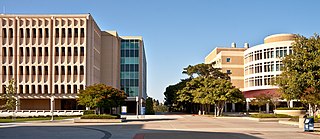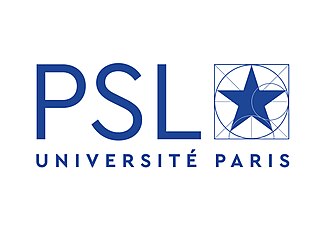
The Australian National University (ANU) is a public research university and member of the Group of Eight, located in Canberra, the capital of Australia. Its main campus in Acton encompasses seven teaching and research colleges, in addition to several national academies and institutes.

The Technical University of Munich is a public research university in Munich, Germany. It specializes in engineering, technology, medicine, and applied and natural sciences.

The Max Planck Society for the Advancement of Science is a formally independent non-governmental and non-profit association of German research institutes. Founded in 1911 as the Kaiser Wilhelm Society, it was renamed to the Max Planck Society in 1948 in honor of its former president, theoretical physicist Max Planck. The society is funded by the federal and state governments of Germany.

The Texas A&M University College of Science was an academic science college of Texas A&M University in College Station. It was founded in 1924. The faculty included a Nobel laureate and three National Academy of Sciences members. The college was dissolved in 2022, two years before what would have been its 100th year in existence.

Brian Paul Schmidt is a Distinguished Professor and astrophysicist at the Australian National University's Mount Stromlo Observatory and Research School of Astronomy and Astrophysics. He was the Vice-Chancellor of the Australian National University (ANU) from January 2016 to January 2024. He is known for his research in using supernovae as cosmological probes. He previously held a Federation Fellowship and a Laureate Fellowship from the Australian Research Council, and was elected a Fellow of the Royal Society (FRS) in 2012. Schmidt shared both the 2006 Shaw Prize in Astronomy and the 2011 Nobel Prize in Physics with Saul Perlmutter and Adam Riess for providing evidence that the expansion of the universe is accelerating.

The College of Natural Sciences at The University of Texas at Austin offers 10 Bachelor of Arts majors, 42 Bachelor of Science majors, and 20 graduate programs to more than 11,000 undergraduates and 1,400 graduate students. The college employs over 370 faculty. Many of the programs are consistently ranked in the top ten nationally, according to U.S. News & World Report (2019), including: Analytical Chemistry (4th), Applied Math (9th), Artificial Intelligence (8th), Computer Science (10th), Computing Systems (8th), Computing Theory (7th), Cosmology/Relativity/Gravity (10th), Ecology, Evolution and Behavior (6th), Mathematics Analysis (7th), Plasma Physics (3rd), Programming Language (8th), and Topology (8th). It was established in 1883.
The Faculty of Science is one of eleven faculties at McGill University in Montréal, Québec, Canada. With roots tracing back to 1843, the Faculty currently offers several undergraduate and graduate programs ranging from Earth Sciences to Mathematics to Neuroscience. Notable alumni of the Faculty of Science include several astronauts and Nobel Prize winners.

The Monash University Faculty of Science is one of the largest science faculties in Australia, with over 4,000 students. It offers undergraduate and postgraduate courses, from Bachelor's degrees through to Masters and PhDs. It is based at the Monash Clayton campus in Melbourne, and has extended to Selangor, Malaysia as the School of Science.

Kenneth Charles Freeman is an Australian astronomer and astrophysicist who is currently Duffield Professor of Astronomy in the Research School of Astronomy and Astrophysics at the Mount Stromlo Observatory of the Australian National University in Canberra. He was born in Perth, Western Australia in 1940, studied mathematics and physics at the University of Western Australia, and graduated with first class honours in applied mathematics in 1962. He then went to Cambridge University for postgraduate work in theoretical astrophysics with Leon Mestel and Donald Lynden-Bell, and completed his doctorate in 1965. Following a postdoctoral appointment at the University of Texas with Gérard de Vaucouleurs, and a research fellowship at Trinity College, Cambridge, he returned to Australia in 1967 as a Queen Elizabeth Fellow at Mount Stromlo. Apart from a year in the Kapteyn Institute in Groningen in 1976 and some occasional absences overseas, he has been at Mount Stromlo ever since.

The School of Physical Sciences is an academic unit of the University of California, Irvine (UCI) that conducts academic research and teaching in the field of physical sciences. It offers both pre-professional training and general education in the departments of chemistry, earth system science, mathematics, and physics and astronomy. The school enrolls 1,400 undergraduate and graduate students and is one of the top schools in the nation in the number of degrees it confers in the area of physical sciences. It also offers specializations such as biochemistry, statistics, math for economics, applied and computational mathematics, astrophysics, applied physics, biomedical physics, and education. In 1995, the school gained international prominence when Frank Sherwood Rowland, a professor in chemistry and Frederick Reines, a professor in physics, won the Nobel Prize in their respective fields. It was the first time two people won the prize in the same year in two different fields at the same public university.

The College of Natural Science (NatSci) at Michigan State University is home to 27 departments and programs in the biological, physical and mathematical sciences.
The Eberly College of Science is the science college of Penn State University, University Park, Pennsylvania. It was founded in 1859 by Jacob S. Whitman, professor of natural science. The College offers baccalaureate, master's, and doctoral degree programs in the basic sciences. It was named after Robert E. Eberly.

The Department of Physics at Durham University in Durham, England, is a physics and astronomy department involved in both undergraduate and postgraduate teaching and scientific research.

The academic structure of the Australian National University is organised as seven academic colleges which contain a network of inter-related faculties, research schools and centres. Each college is responsible for undergraduate and postgraduate education as well as research in its respective field.

Paris Sciences et Lettres University is a public research university based in Paris, France. It was established in 2010 and formally created as a university in 2019. It is a collegiate university with 11 constituent schools, with the oldest founded in 1530. PSL is located in central Paris, with its main sites in the Latin Quarter, at the Montagne Sainte-Geneviève campus, at the Jourdan campus, at Porte Dauphine, and at Carré Richelieu.
The College of Science, Mathematics, and Technology was the science college of the former (1992-2015) University of Texas at Brownsville. It consisted of six academic departments at the time. The six departments employed diverse faculty members - many of whom are leading experts in the fields - who have received funding from a variety of funding agencies, including the National Science Foundation, the National Institutes of Health, the Department of Education, and the Department of Defense, among others. The average active ongoing external funding is about 25-30 million dollars. In 2002, the Center for Gravitational Wave Astronomy (CGWA) research center was founded to help "develop excellence in research and education in areas related to gravitational wave astronomy."

The ANU College of Health & Medicine is an Australian university college for the study of medicine, psychology, mental health, epidemiology and population health at the Australian National University (ANU), located in Canberra, the capital city of Australia.
Peter G. Tuthill is an Australian astronomer who has pioneered the science of high-angular resolution astronomy, leading the development of aperture masking interferometry and astronomical optical interferometry. He is a professor of astrophysics at the School of Physics at the University of Sydney and was Director of the Sydney Institute for Astronomy (SIfA) of School from 2010 to 2015.













